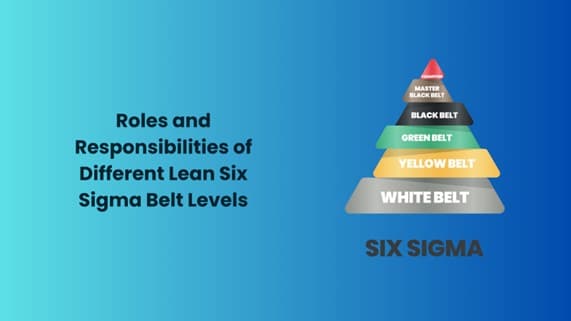Roles and Responsibilities of Different Lean Six Sigma Belt Levels
Unveiling the Spectrum: Navigating Lean Six Sigma Belt Levels

The Lean Six Sigma Course has established itself as a titan of process improvement approaches, giving professionals the tools to improve efficiency and simplify processes. The Lean Six Sigma Belts, which stand for various degrees of knowledge and responsibility within a company, are the foundation of this system.
Think of Lean Six Sigma belts as a way to show how much someone knows about improving how a company works. It’s similar to how martial artists earn different belts to show their skills. Here is the different levels of Lean Six Sigma belts and what each level does to help organizations become better and more efficient.
Different levels of Lean Six Sigma belts
Yellow Belt: Laying the Foundation
The first step into the realm of Lean Six Sigma is the Yellow Belt. The key ideas of the technique are fundamentally understood by those who reach this level. Yellow Belts are like important team players in Lean Six Sigma. To collect data, analyse it, and map out strategies for improvement, they collaborate closely with Green Belts and Black Belts. They are all focused on using data to inform wise judgements and developing creative solutions to issues. Yellow Belts assist in implementing those solutions and monitoring progress. They’re often the ones right on the front lines of improvement projects, making sure everything runs smoothly.
Green Belt: Driving Process Improvements
Green Belts are armed with a stronger grasp of Lean Six Sigma principles as they go up the responsibility scale. Green Belts are like the project leaders in their specific areas of expertise. Smaller improvement initiatives fall under their purview, and they are in responsible of collecting and analysing data, finding problems with procedures, and creating strategies to fix them. They work closely with Black Belts to improve company outcomes by streamlining processes. For these breakthroughs to occur and be quantifiable, their project management skills are crucial. The main goal of green belts is to establish a continual improvement culture within their organisations.
Black Belt: Guiding Strategic Transformation
The Black Belts, who are specialists in cutting-edge statistical analysis and problem-solving approaches, are at the centre of Lean Six Sigma deployment. These experts take on bigger, trickier initiatives that significantly affect the bottom line of a business. Black Belts is in charge of supervising project portfolios, guiding strategic decision-making, and mentoring Green Belts. They use their aptitude for analysis to pinpoint problems’ underlying causes and provide creative fixes. Black Belts are change agents who spearhead projects to reform specific areas.
Master Black Belt: Orchestrating Excellence
The Master Black Belt represents the highest level of Lean Six Sigma proficiency within a company. They act as trainers and mentors for Green and Black Belts since they have unmatched system commands. Their responsibilities include:
- Developing the organization’s Lean Six Sigma strategy.
- Offering advice on challenging projects.
- Making sure that processes are uniform across the board.
The long-term success of Lean Six Sigma efforts depends on the creation of new techniques, the promotion of innovation, and the work of Master Black Belts.
Champion: Advocating for Improvement
The position of a Champion is critical to the success of Lean Six Sigma initiatives, even if it is not included in the conventional belt hierarchy. High-level managers or executives who support efforts for process improvement are known as champions. They offer the tools, encouragement, and strategic guidance essential for Lean Six Sigma initiatives to succeed. Champions play a critical role in coordinating improvement initiatives with corporate objectives and fostering a culture of continuous improvement throughout the firm.
-
How To Open A Profitable Business In The Metaverse Era
-
How to Find and Buy from Businesses on WhatsApp
-
How AI Will Change Business Forever in 2022
Conclusion
The different Lean Six Sigma Belt levels work together like a well-tuned symphony, with each member performing a specific part to provide a unified operational efficiency. Every level of the organization, from the foundation-laying Yellow Belts to the game-changing Master Black Belts, contributes to its quest for perfection. Professionals who advance through these belts not only gain knowledge and abilities but also a philosophy of constant growth that permeates the workplace culture. for businesses to do well in the long run, they should adopt the tasks and roles of different levels in Lean Six Sigma.







